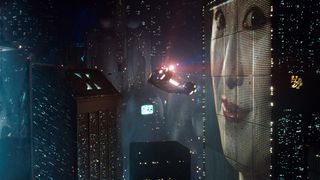From cyberpunk to the infinite: celebrating the influence of VFX maestro Douglas Trumbull
The man who brought the future to life passed away this week

You may not know his name. You may not have even seen the films he worked on, unlikely as that may be. But, if you love sci-fi in any visual medium, your favorite genre has been influenced by the work of visual effects maestro Douglass Trumbull, who sadly passed away this week, aged 79.
Trumbull’s credits read like a run down of sci-fi cinema’s greatest hits: 1968’s 2001: A Space Odyssey; 1977’s Close Encounters of the Third Kind; 1979’s Star Trek: The Motion Picture; 1982’s Blade Runner. This is merely an abridged list of films he worked on – Trumbull was so talented and in demand in the 70s and 80s that he turned down working on Star Wars.
His work on Blade Runner, along with visual artist and futurist Syd Mead, is arguably most influential today. Here is a vision of the future that appears presciently bleak – all smoke, fire and rain, neon-drenched slums, flying cars and grandiose, pyramidical mega-corp megastructures.
Trumbull’s depiction of storeys-high video screens and projections on overhead blimps foreshadows the barrage of information we absorb in our metropolises, and should be treated as a warning of the oppressive white noise that an AR metaverse could bring into reality today. Trumbull’s opening effects shot of a camera panning over a flaming, smog wrapped LA feels eerily close to, say, the factory cities we see in China’s still-booming tech manufacturing provinces.
Blade Runner is the epitome of cyberpunk, and its visual language has been aped by everything from Netflix’s Altered Carbon TV show to CD Projekt Red’s Cyberpunk 2077 video game. Trumbull’s work is instrumental to that ongoing influence. Without it, there’s no Blade Runner, no Cyberpunk 2077, no Deus Ex, and no Final Fantasy VII – at least in terms of how large portions of those games and other entertainment media look.
Touching tech
Trumbull's influence may even extend further still. Indeed, there are arguably hints of Space Odyssey's sterilized but futuristic stylization in the world of consumer tech industrial design.
There’s an obvious through-line between the white, sleek, NASA-chic of 2001: A Space Odyssey and the design of the original iPod. The product that’s arguably the kickstarter for Apple’s modern-day mobile tech dominance, Jony Ive’s design had a curved white casing that would have looked right at home as a prop within director Stanley Kubrick’s sci-fi classic, as much as it referenced Dieter Ram’s design principles at Braun.
Get the best Black Friday deals direct to your inbox, plus news, reviews, and more.
Sign up to be the first to know about unmissable Black Friday deals on top tech, plus get all your favorite TechRadar content.
And if there’s any doubt that it was more than a fluke, the iPhone 4’s all black slab build, a design language that has been retained throughout the iPhone line up ever since, was a dead ringer for 2001: A Space Odyssey’s ominous monolith. While it’s difficult to draw the line between where Trumbull’s efforts end and director Kubrick’s begins in terms of the film’s overall look (the two famously fell out over crediting of the film’s effects work), the stark look of 2001: A Space Odyssey has permeated so indelibly into our expectations of futuristic living that consumer technology, our most-forward thinking and future-gazing household items, can’t help but have been indirectly inspired.
Trumbull’s influence on technology was – at crucial points – more direct, too. He was instrumental in the development of the Showscan camera system, which anticipated the modern obsession not only with high definition content, but also screens and projections that display in a higher frame rate than the 24 frames per second standard that film is traditionally shown in. He also designed the digital capture and projection system Magi, shooting and projecting content in native 3D at 4K resolutions and at 120fps.
Through his company Skyride, Trumbull also advanced the sort of simulator technology you find in theme park rides (he directed the legendary Back to the Future: The Ride at Universal Studios), being a precursor to the 4DX screens seen in some cinema multiplexes. He was even briefly the Vice Chairman of the IMAX corporation.
Beyond the infinite
But it’s perhaps Trumbull’s work on a key scene from 2001: A Space Odyssey that’s most pertinent to this week’s news.
In the film’s climactic “Beyond the Infinite” chapter, Trumbull’s breathtaking Star Gate sequence depicts space travel past the realms of human comprehension. A dazzling display of lights, and a kaleidoscopic visual interpretation of adventure into the uncharted realms of the universe and the mind, it used pioneering camera techniques to conjure the dread and awe of the unknown. It’s a scene easily interpreted as the journey from life to death and whatever awaits beyond.
What Trumbull leaves us with is an incredible body of work. By embracing innovation, technology and imagination, Douglas Trumbull let us take a glimpse at an as-yet unrealized future. That it has, at times, seemed like a model for the present, is a testament to his influence, and a stark reminder of our potential slide into dystopia.
Gerald is Editor-in-Chief of iMore.com. Previously he was the Executive Editor for TechRadar, taking care of the site's home cinema, gaming, smart home, entertainment and audio output. He loves gaming, but don't expect him to play with you unless your console is hooked up to a 4K HDR screen and a 7.1 surround system. Before TechRadar, Gerald was Editor of Gizmodo UK. He is also the author of 'Get Technology: Upgrade Your Future', published by Aurum Press.
Most Popular




